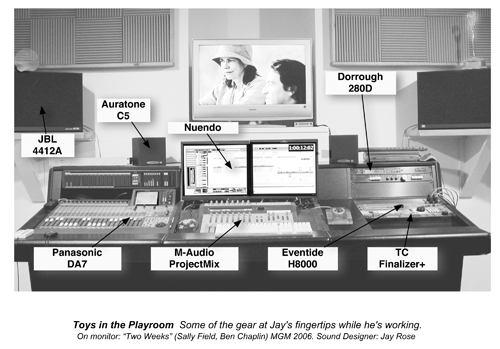JV: What do you use for monitors?
Jay: I’m using JBL4412a’s, in a nearfield, in a tuned room. When I did this film mix, we were in a THX room, because we were mixing Dolby surround. All of the tracks are things that I had prepared in my studio. When we walked into the THX room, everything sounded exactly the way I expected it to.
I did an IMAX track. You’re familiar with the whole IMAX experience, with 6.1 sound and the six-inch wide film that’s projected on a spherical screen that surrounds you. I did an audio only show to demonstrate the capabilities of the IMAX theatre at the Museum of Science in Boston, and we mixed it there. I did everything at my studio on the JBL monitors, and then one midnight, I went over with a couple of digital recorders and a systems engineer and the director, and I patched into the theatre’s system so that I could do my final mix on their speakers in the room. Everything translated beautifully.
So I am very, very happy with the JBLs. What I like particularly about this series, the 44 series, is that they are so accurate on voice. They give you the whole mix, but they also let you hear everything that’s going on in the voice. Typical music speakers are hyped. They’ve got extra bass, they’ve got extra treble. They sound great on music, but there’s not that much going on accurately in the mid-range. And frequently, there will be a crossover right in the middle of the consonant range of the voice. What it does is, it very subtly distorts the voice/music mix. So if you’re doing a commercial, you may end up making the voice too loud or too soft when it’s played on a good speaker, if you’re listening on music speakers when you do it. So my stuff is always loud, bright, and clear.

JV: Tell us about the rest of your studio.
Jay: For a long, long time, I was using the Orban workstations. Orban stopped development on it in the year 2000. When Orban left Harman International – not Bob, but the company – and became a part of CRL, they decided to concentrate on the transmitter processors, which was what CRL was doing before they bought Orban. They stopped development on the workstations. The Audicy was such a killer when it was new, but in 2000, they stopped writing software for it, and by ’05, when I started working on the Sally Field movie, it was just too old hat. It couldn’t handle a film. So I went looking for other ways to go.
JV: What did you get?
Jay: Well, I’m not going to get into the relative merits of the elephant in the room, but bear in mind, I got a lot of money. The game of radio has been very good to me. I could afford virtually anything that I could name. My wife was saying, “For heaven’s sakes, you’ve been using this Orban system since the DSE. You’ve been editing on this box essentially for 15 years, and just upgrading it. Whatever you buy, you know you’re going to use for another 15 years. If it costs you a hundred grand, spend the hundred grand.” I didn’t spend a hundred grand. I’d rather use that for vacation or something. But I went through everything, and I ended up with Nuendo. I love it. I ran parallel, using Nuendo for the film and the Audicy for my radio and TV projects, for about four months. Then I said the heck with the Audicy. I still have it. I keep it for legacy. But the Audicy controller is in a closet. What used to be the Audicy controller is now a controller for Nuendo. Different hardware, and that space is now owned by Nuendo. If somebody wants to go back into an Audicy project, I can still fire the thing up. It’s probably worth more for me to keep than to try to sell.
JV: Would you recommend Nuendo for radio production? I think Pro Tools and Audition are the two leaders in radio right now.
Jay: Yes. Still, 30 to 40 percent of my stuff is audio only. And I also have both Pro Tools and Audition. When I did the film, I noticed that everybody in LA uses Pro Tools. And you can hire a Pro Tools operator for minimum wage, because of all the schools that teach it. I can tell you a story about that. My son is the assistant chief at a big radio complex in town. He was watching me edit one day and he said, “You know, we have to get this,” and he went to the operations manager and he said, “My dad’s got this Nuendo here, and he can do so much more than our guys are doing in Pro Tools.” And the office manager said, “Yeah, but I can hire a Pro Tools guy fresh out of school, and I don’t have to pay my production people that well” — because there’s so many Pro Tools operators.
Anyway, yeah, I have a Pro Tools rig. I stopped upgrading it a year ago, so mine topped out at Version 6.9. I have Audition, so that I can write about it, and it’s a cool program. But I can do so much stuff so fast in Nuendo.
